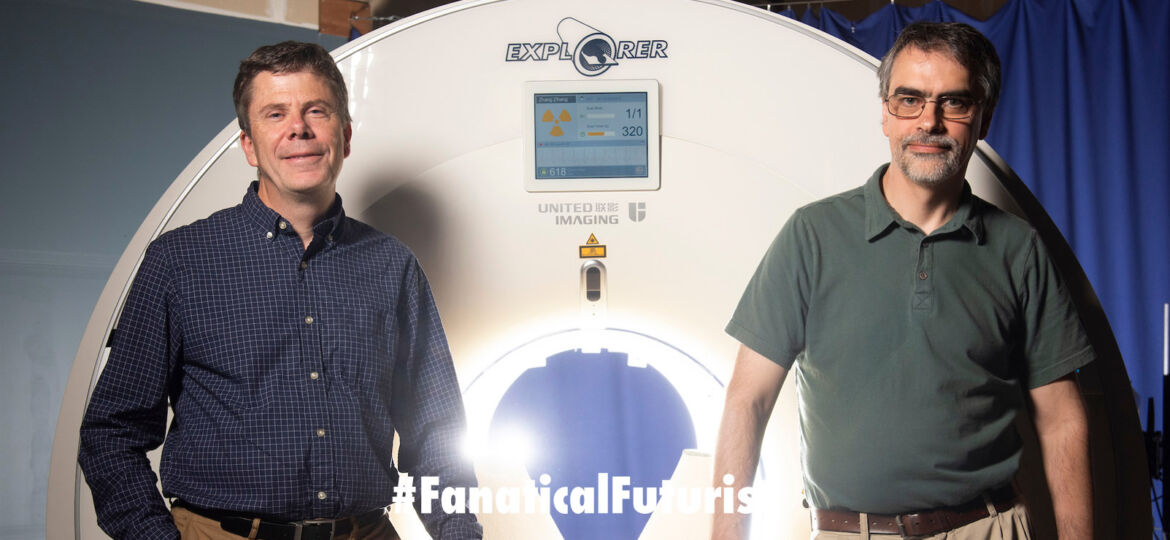
WHY THIS MATTERS IN BRIEF
Medical scanners haven’t advanced much in decades, this new scanner is faster, higher resolution and produces insights into the human body not possible using today’s technology.
Recently I talked about a new innovation that lets doctors create movies of the behaviour of cells in a living patient in real time in hi definition. Now after over a decade of development the world’s first full body medical scanner, and a potential replacement for today’s increasingly aged hospital CT and PET scanners, has produced its own stunning real time images of the human body in a move that many think will help revolutionise hospital scanning systems. Furthermore the new imaging device is almost 40 times faster than the current cream of the crop and can capture and create a 3D picture of the entire human body in just one instant scan.
Called EXPLORER, the new full body scanner combines the best of Positron Emission Tomography (PET) and X-Ray Computed Tomography (CT) scanners, and the first human sized device was released earlier this year.
Find out how it works
Developed in a collaboration between scientists from University of California, Davis and engineers from China based United Imaging Healthcare, the very first human images from the scanner were revealed this week, and the results are being described as nothing short of incredible by the international medical community. Subsequently, and unsurprisingly, the research team behind the breakthrough system suggests that EXPLORER could revolutionise both clinical research and patient care.
“The level of detail was astonishing, especially once we got the reconstruction method a bit more optimized,” says Ramsey Badawi, chief of Nuclear Medicine at UC Davis Health. “We could see features that you just don’t see on regular PET scans. And the dynamic sequence showing the radiotracer moving around the body in three dimensions over time was, frankly, mind-blowing. There is no other device that can obtain data like this in humans, so this is truly novel.”
The new EXPLORER scanner offers remarkable improvements over current imaging systems. As well as offering faster scans, producing a whole-body image in as little as 20 to 30 seconds, the device is effectively up to 40 times more sensitive than current commercial scanning systems.
This means the scanner can produce detailed images using significantly lower doses of radiation tracers than are currently needed which is good news for patients and doctors alike. The higher sensitivity also allows clinicians to image certain molecular targets that are beyond the limits of current scanning systems, giving them new insights into diseases and the health of patients.
“The trade off between image quality, acquisition time and injected radiation dose will vary for different applications, but in all cases, we can scan better, faster or with less radiation dose, or some combination of these,” says Simon Cherry, from the UC Davis Department of Biomedical Engineering.
Perhaps the most exciting and novel application of this new scanning system is its ability to capture entire body images in single momentary scans. Current PET systems are fundamentally slow and inefficient due to the necessity of having to scan single slivers of the body at one time. Over a long stretch of 30 or 40 minutes all these smaller images are aggregated into a larger 3D image, however this significantly limits the ability of clinicians to measure the effects of something moving across the entire body in real time.
In an age when companies and governments are using traditional scanners to create digital avatars of patients that can be analysed by AI’s that use them to diagnose a myriad of things, from heart and lung disease, to even the patients estimated death date, the EXPLORER promises an entirely new kind of diagnostic imaging that could, for example, measure blood flow or the way a person takes up glucose, in real time across the entirety of the body.
The new imaging system still has some testing and verification ahead before it moves into commercial production but Cherry is optimistic it shouldn’t be too long before it is available to hospitals and research bodies worldwide.
“I don’t think it will be long before we see at a number of EXPLORER systems around the world,” says Cherry. “But that depends on demonstrating the benefits of the system, both clinically and for research. Now, our focus turns to planning the studies that will demonstrate how EXPLORER will benefit our patients and contribute to our knowledge of the whole human body in health and disease.”
The new research will be presented at the upcoming Radiological Society of North America Annual Meeting in Chicago.
Source: UC Davis
















